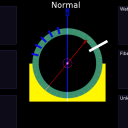Critical Angle
From Algodoo
Critical Angle
| Language: | English |
|---|---|
| Description: | This lesson is designed to help students explore the idea of critical angle and help reinforce the idea that it only exists when going from a slow to a large to a small index of refraction. |
| Target: | Key Stage 4, Key Stage 5 |
| Category: | Laboratory |
| Discipline: | Optics |
| Learning objectives: |
|
| In class: | Students should be familiar with the idea of refraction before engaging this activity.
Start by reviewing with students what happens when light travels from a small to a large index of refraction and vice versa (bends towards the normal and away from the normal respectfully). Make sure they realize that as the incident angle increases, the refraction angle increases (according to Snell’s Law). Focusing on the example of going from a large index of refraction to a small index of refraction, ask them what will happen when the incident ray refracts so much that it travels across the surface of the material. Have them record their predictions then discuss them as a class. After several students have expressed their ideas and thought process, have them discover for themselves by engaging this Algodoo activity. |
Steps in Algodoo
CREATE A SCENE
Open the ‘Index of refraction’ scene above.
MAKE A PREDICTION
Make a prediction as to what will happen when a beam of light travels from a large to small index of refraction and refracts so much that the refracted ray travels along the surface of the material.
RUN/INTERACT
There are six clear blocks made of different materials. Four of the six have their printed index of refraction on the block. Starting with the water block, place it so that it covers the bottom half of the circle (it should perfectly fit over the yellow block). Position the laser so that it is directly at the bottom of the circle pointing upward. Slowly rotate the laser around the circle to either side. Notice the refracted ray should refract away from the normal. Keep rotating the laser until the refracted ray travels across the surface of the block. Record your observations (including what angle this happens at). Now rotate the laser a bit more and record what happens. blocks.
EVALUATE
Was your prediction correct? Was there any correlation between the angle this occurred at and the indexes of refraction? Why does this reflecting not occur when the laser travels from the air into the block?
REVISE SCENE
Now place a block on the top half of the circle as well (so that the two blocks overlap a tiny bit) and repeat the process looking for the angle at which the light begins reflecting at (make sure the light is always going from a large index of refraction to a smaller one). You may need to use the white lever to turn the circle under the blocks.
MAKE A PREDICTION
How do you think this will affect the angle at which the light begins reflecting at?
RUN/INTERACT
Rotate the laser with the new block configuration and record your results.




